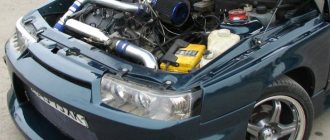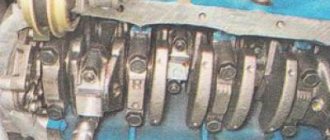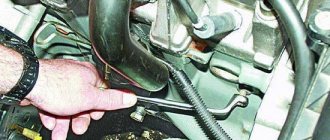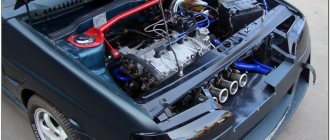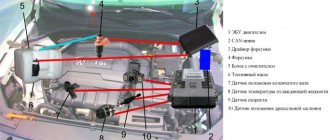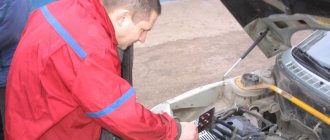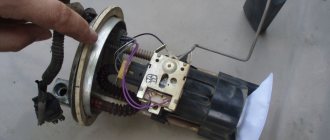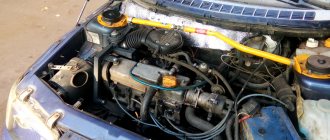The domestic “ten” is a fairly popular car at the moment, and it gained its popularity due to its low cost and maintainability. The VAZ 2110 is a car for all occasions; it has good reliability and excellent technical characteristics, because it is not without reason that many different engines were installed on it.
The VAZ 2110 was equipped with carburetor and injection engines with a volume of 1.5 liters to 1.6 liters. This Lada model even had a rotary engine with a power of up to 140 hp.
This article talks about the engines installed on the VAZ 2110, namely their technical characteristics, pros and cons.
VAZ 2110 injector 16 valves, engine characteristics, timing device
The VAZ 2110 16-valve injector became another design breakthrough for AvtoVAZ. Finally, the 4-cylinder power units of the domestic manufacturer received a modern timing system with two camshafts and 4 valves per cylinder. In total, two main 16-valve injectors were installed on the “ten”. This is a 1.5 liter engine of the 2112 and 21124 1.6 liter models.
The most interesting thing is that the 1.5-liter injection engine is more powerful than its larger brother. The VAZ-2112 engine develops 93.5 horsepower, while the VAZ-21124 has only 89 hp. The compression in the 1.5 liter 16-valve engine is slightly higher. However, the 2112 motor has one drawback. If the belt breaks, the valves bend, which leads to very expensive repairs. For the VAZ-21124 engine, this problem was solved by making special recesses for the valves in the piston bottoms; this, of course, reduces compression, but the valves do not bend if the timing belt breaks.
Service
VAZ 2110 engines are serviced quite typically. Thus, scheduled maintenance is carried out within 10-15 thousand kilometers. If the vehicle is operated on LPG, then maintenance must be reduced to 8-10 thousand km in order to preserve the engine and extend its service life.
When servicing, it is necessary to pour only high-quality oils into the VAZ 2110 engine. Thus, there are a number of lubricating fluids that must be poured into the engine.
Do not forget about using a high-quality oil filter, which will also affect the service life. The power unit maintenance scheme is quite simple, and is provided by AvtoVAZ in the repair manuals.
The VAZ 2110 8 valve engine is quite unpretentious in the use of oil. So, both semi-synthetic and synthetic lubricant are ideal for him. Many car enthusiasts ask the question: how much oil should be poured into the engine? Almost all engines require 3.5 liters of oil.
Characteristics of VAZ 2110 injector 16 valves
In technical terms, the 16-valve engines of the VAZ 2110 are almost the same, however, due to the difference in working volumes, there are some differences. So the 21124 engine has an increased piston stroke, so the height of the cast-iron cylinder block is several millimeters larger. The cylinder diameter of both engines is the same - 82 mm. Below are more detailed technical characteristics of the “tens” injection engines with 16 valves.
VAZ 2110 injector 16 valves 1.5 liters
- Working volume - 1499 cm3
- Number of cylinders - 4
- Number of valves - 16
- Cylinder diameter - 82 mm
- Piston stroke - 71 mm
- Power - 93 hp (68 kW) at 5600 rpm
- Torque - 128 Nm at 3800 rpm
- Compression ratio - 10.5
- Power system - distributed injection
- Acceleration to 100 km/h - 12.5 seconds
- Maximum speed - 180 kilometers per hour
- Average fuel consumption - 7.2 liters
VAZ 2110 injector 16 valves 1.6 liters
- Working volume - 1596 cm3
- Number of cylinders - 4
- Number of valves - 16
- Cylinder diameter - 82 mm
- Piston stroke - 75.6 mm
- Power 16 cl. - 89 hp (65.5 kW) at 5600 rpm
- Torque 16 cl. — 131 Nm at 3800 rpm
- Compression ratio - 10.3
- Power system - distributed injection
- Acceleration to 100 km/h - 12 seconds
- Maximum speed - 185 kilometers per hour
- Average fuel consumption - 7.2 liters
With all the advantages of the 16-valve petrol engine of the VAZ-2110, this power unit is technologically more complex than its 8-valve counterparts. The cylinder head is made of aluminum alloy and has quite impressive dimensions. Banal valve adjustment takes quite a long time, and major repairs of the cylinder head of a 16-valve engine are quite a labor-intensive undertaking.
Most often, almost all owners of 16-valve injection engines “tens” are faced with replacing the timing belt, which also requires increased attention. After all, there are already two camshaft pulleys, plus a timing belt idler pulley is added. When installing a new belt, you must align three marks on the camshaft pulleys and the crankshaft pulley. In theory, it looks something like this, as in the image below.
This is a detailed timing diagram of a 16-valve VAZ-2110 injector . And this is what it looks like in a real photograph of an installed timing belt.
The timing device of the VAZ 2110 injector 16 valves is, in principle, little different from the design of DOHC engines of foreign cars. So if you have experience replacing a belt on a “ten”, then this operation will not cause problems on other cars with the same engine. It is worth recalling once again that incorrect installation of the belt on a 16-valve 1.5-liter engine can lead to bent valves. So be sure to double-check that all marks match clearly. Also, the belt must be sufficiently tensioned, otherwise the timing belt may jump, which will cause inevitable problems.
Schematic sketch of the VAZ-2112 engine
Detailed diagram of the VAZ-2112 engine.
1 – engine sump. 2 – front crankshaft oil seal. 3 – crankshaft. 4 – crankshaft pulley. 5 – oil pump. 6 – generator drive pulley. 7 – timing belt. 8 – front cover of the timing mechanism drive. 9 – coolant pump pulley (pump). 10 – tension roller. 11 – camshaft toothed pulley. 12 – rear cover of the timing mechanism drive. 13 – camshaft oil seal. 14 – exhaust camshaft. 15 – hydraulic pusher. 16 – valve spring. 17 – valve guide sleeve. 18 – exhaust valve. 19 – receiver. 20 – camshaft bearing cover. 21 – guide pipe. 22 – cylinder head cover. 23 – plastic cover. 24 – spark plug. 25 – intake camshaft. 26 – inlet valve. 27 – cylinder head. 28 – coupling. 29 – fuel rail. 30 – crankcase ventilation hose. 31 – nozzle. 32 – intake manifold. 33 – flywheel. 34 – crankshaft rear oil seal holder. 35 – rear crankshaft oil seal. 36 – cylinder block. 37 – oil dipstick. 38 – piston. 39 – connecting rod. 40 – connecting rod cover. 41 – crankshaft main bearing cover.
Engine device
16-valve 124 engine under the hood of a “two-wheeler”
- The engine is a sixteen-valve, in-line, four-stroke gasoline engine, consisting of four cylinders. The operating order of the cylinders is: 1-3-4-2 – starting from the crankshaft pulley. With a power supply system – distributed injection, controlled via a Bosch, “January” or GM controller.
- The engine is secured in the engine compartment using four elastic supports, of which the front and rear are rods that are fixed from the engine to the body, and the left and right are identical to the VAZ-2110(11).
- On the engine, on one side there are camshaft and crankshaft drives, a coolant pump (about checking the pump and choosing a pump - note), a generator, as well as a timing belt (about replacing it here), on the other side there are sensors: coolant temperature, pressure oil, starter, thermostat, front: ramp with injectors, intake manifold, oil dipstick, knock sensor, crankcase ventilation hose, phase sensor. On the reverse side: oil filter, crankshaft position sensor, exhaust manifold. Top: spark plugs, high-voltage wires. More details about all sensors are written here.
- The cast-iron cylinder block has the same index “21083” with engines from the VAZ-2110 (11), however, they have different screws for the cylinder heads M10x1.25 in contrast to M12x1.25, as well as their smallest entry depth.
- Each engine has its own serial number.
Cylinders
This is what the cylinder block looks like with the engine removed.
The engine cylinders are bored directly into the block. The initial diameter is 82 mm and during repairs can be increased by 0.4 or 0.8 mm. The class of the cylinder is marked on the bottom plane of the block in Latin letters.
Crankshaft
This element practically does not fail.
The crankshaft is made of high-strength cast iron, and is equipped with five main journals, four connecting rod journals, and eight counterweights cast together with the shaft. The difference between this crankshaft and its analogues with the VAZ-2112 is due to its increased strength and wear resistance, so installation from younger models is completely excluded. The flywheel is secured to the back of the crankshaft using six self-locking bolts.
Pistons
These pistons apparently already have grooves for the valves. They won't be driven down anymore.
The piston in the engine is made of aluminum alloy, the piston skirt is conical in the longitudinal section, and oval in the transverse section. A distinctive feature of the pistons for the VAZ-2112 is that they have four recesses for the valves to avoid bending and subsequent replacement of the valves, whereas on younger models they are flat. For one engine, pistons should be selected based on weight, not allowing a difference of more than 5 grams, to reduce the imbalance of the crank mechanism (approx.). There are three rings mounted on the piston: the upper ones are compression rings that prevent gases from breaking through into the engine crankcase; they also help remove heat from the piston to the cylinder. The lower ring is an oil scraper ring (about replacing it here).
Connecting rods
As a rule, they are changed along with the pistons.
The connecting rods are made of steel and are divided into weight classes - they are marked with paint or a letter on the cover. On the covers, as well as on the connecting rods, the cylinder number is stamped (it should be on one side of the connecting rod and the cover).
Piston pins
This is what a piston pin looks like.
The piston pin is steel, tubular in section. It is secured from falling out by two retaining spring rings, which are located in the grooves of the piston bosses. Based on their diameter, they can be divided into three different classes: 1 – 21.978-21.982 ; 2 – 21.982-21.986 ; 3 – 21,986-21,990 . The piston class is also stamped on its bottom. The piston and pin must be of the same class.
View of the cylinder head on a dismantled engine.
Cylinder head - made of aluminum alloy, common to all four cylinders, centered on the block with two bushings and secured with ten screws. On the top of the cylinder head there are camshaft supports, five on each side.
Camshafts
Camshafts and their pulleys
The camshafts are cast, cast iron, five-bearing, each with eight cams. The camshafts are driven by a toothed belt from the crankshaft. Due to increased loads on the timing belt, its width in the VAZ-2112 engine, compared to analogues 2110(11), has been increased from 19.0 to 25.4 mm (accordingly, the width of the toothed pulleys and rollers has been increased). Therefore, the timing belt tension has also changed. There is a support roller under the intake camshaft pulley, and a tension roller under the exhaust camshaft.
Valves
These valves are not afraid of bending if there are grooves on the pistons.
The valves are made of steel, while the outlet is made of heat-resistant steel with a directional chamfer, and the inlet area is larger than the outlet. If we compare in size, they are smaller than the analogues of the “tenth” model. They are arranged in two rows in a V-shape. They are driven by cams using hydraulic pushers, which in turn are very sensitive to the purity of the oil and its quality. And in the presence of mechanical impurities, premature failure of these elements is possible, which will be accompanied by increased noise during the operation of hydraulic pushers. How to replace these elements is described in detail in this article.
Procedure for removing oil injectors
Before you begin removing injectors from any car of the tenth VAZ family, you will need to relieve the pressure in the fuel system. Removing any element that is under pressure in any way can result in personal injury.
How to get rid of excess fuel
To relieve the existing fuel pressure, you need to turn off the fuel pump and exhaust the remaining gasoline:
- Fold down the cushion from the back row of seats.
- Below it is the fuel tank hatch.
- Unscrew the screws securing the hatch.
- Disconnect the wiring harness from the pump housing (the wires supply power).
After this, start the engine and wait until it stalls. It is recommended to turn the ignition on several times to ensure that there is no gasoline left in the system.
Next, you can begin to remove the injectors. It is recommended to prepare the necessary tools in advance:
- open-end wrench 17;
- a flat screwdriver with a narrow blade;
- Phillips screwdriver;
- hex key 6;
- rags.
All elements of the repair kit are usually at hand for any driver
How to remove parts from the engine
- Remove the air filter box (it will interfere with free access to the engine).
- Remove the wiring harnesses from the injectors.
- Then you will need to disconnect the wires from the idle speed control and from the throttle sensor.
- Next, remove the vacuum seal from the pressure regulator (it has a white braid).
- Using a 17 key, unscrew the bolts that secure the fuel frame to the body. To make it more convenient, you can remove the gas cable.
- It is better to unscrew the fasteners of the plate with which the ramp is pressed using a hexagon.
- The fuel rail must be removed very carefully, with the nozzles facing up.
- On a 16-valve engine, dismantling will take longer, since the ramp has a more complex structure and several types of fasteners.
- Next, you can remove the injectors themselves - to do this, disconnect the fastening brackets of the electrical connector with your finger, and then the injector bracket. During removal, gasoline may leak; it is recommended to place a cloth under the ramp.
To install a new injector, the socket is first thoroughly cleaned of dirt and fuel, and only then can the product be screwed in. It is better to drop a few drops of gasoline onto the rubber ring before installation - this will make the nozzle fit into the mounting hole more easily. All work is then carried out in reverse order.
Advantages of a sixteen-valve engine
We have already said that the internal combustion engines of the VAZ-2110 (2112) family discussed in the article are distinguished by greater power, lower fuel consumption, and also high technical characteristics, unlike the V8s. It's time to find out what design features make the VAZ 2112 16 valve engine such an attractive choice for motorists.
Let’s immediately make a reservation about exactly what “advantages” will be discussed in this section of the article:
- fuel economy;
- higher power;
- detonation resistance;
- advanced cooling system;
- simple tuning due to the separation of the intake and exhaust tracts.
It is the separation between the intake and exhaust tracts in the design of the VAZ-21120 and 21124 engines that makes it possible to achieve quite noticeable fuel savings. Thus, the supply of fuel and the intake of exhaust gases is carried out by a separate spaced valve system, due to which there is no unwanted mixing of fuel and combustion products. It is also obvious that this increases the efficiency of the engine and its power.
Sixteen-valve VAZ 2110 engine
The innovations did not ignore the combustion chamber, as well as the structure of the cylinder block. Their design is slightly modified in such a way that the risk of detonation of the fuel mixture is minimized. This is truly a significant advantage, because the quality of gasoline in our gas stations leaves much to be desired. Accordingly, this kind of internal combustion engine design remains a guarantee of its long service life.
Tuning and modification
Recently, it has become popular to tune the VAZ 2110 engine. Many motorists turn to a tuning studio to carry out the engine modification procedure.
What can you do with the power unit? The tuning scheme is quite simple. Mechanical (boring) and electronic (chip tuning) modifications are carried out. Of course, many car owners only chip the engine to reduce consumption or increase power.
Mechanical modification of the power unit involves boring the cylinder block and installing lightweight spare parts. Thus, pistons and valves manufactured by API are installed. The best guide bushings are those from K-line Corporation. As for the guide bushings, there is no need to knock out the old ones, since you can install bronze sleeves that will lighten the weight of the motor.
After mechanical modification, you can no longer fill in ordinary lubricating fluid. Therefore, only high-quality oil for the VAZ 2110 is poured into the tuning version.
After mechanical modifications are completed, an auto electrician comes into play and adjusts the operation of the motor. This could be a regular firmware update of an old engine control unit or a chip installation. For the brains that are installed on VAZ 2110 engines, there is a soldered-in chip or an external connection.
Tuning of the internal combustion engine cylinder block, conversion of the 8 valve VAZ-2110 (2112) engine to 16 valve.
Tell me, after reading all the above-mentioned information, are you not inspired by the idea of having a car with 16 internal combustion engine valves? In this case, you will be pleased to know that this kind of modernization is allowed. Of course, this process is thorough and cannot be completed without careful preparation. But the result will really justify itself. If you have any doubts, just read the next few paragraphs of the text.
Without going into technical details, the essence of tuning is to replace the cylinder head with a new one. Of course, now you will have two camshafts, and you will also have to rack your brains over the fastening system, because the diameters of the holes in the 16 valve head do not correspond to those on the 8 valve head.
The mounting holes of the block head should be drilled, increasing the diameter from 10 to 12 millimeters.
You can do this yourself, but it is better to contact a specialized workshop. For this kind of work they should not charge more than 3-4 hundred rubles. It should also be taken into account that the standard mounting bolt for the 16-valve cylinder block is slightly smaller than that for the “eight” and must be shortened accordingly.
It is better to study in advance what a 16-valve engine is like on a VAZ 2110 and then you will certainly be able to carry out this kind of tuning yourself. It will be necessary to change the timing belt, pump pump, rollers, wiring, spark plugs, connecting rod mechanism and other structural elements due to the peculiarity of the cylinder head. The head is assembled separately before installation on the engine. After completing the work, it is also advisable to use specialized services for setting up and calibrating the operation of the internal combustion engine.

